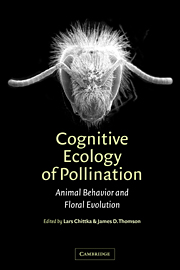Book contents
- Frontmatter
- Contents
- List of contributors
- Preface
- 1 The effect of variation among floral traits on the flower constancy of pollinators
- 2 Behavioral and neural mechanisms of learning and memory as determinants of flower constancy
- 3 Subjective evaluation and choice behavior by nectar-and pollen-collecting bees
- 4 Honeybee vision and floral displays:from detection to close-up recognition
- 5 Floral scent, olfaction, and scent-driven foraging behavior
- 6 Adaptation, constraint, and chance in the evolution of flower color and pollinator color vision
- 7 Foraging and spatial learning in hummingbirds
- 8 Bats as pollinators: foraging energetics and floral adaptations
- 9 Vision and learning in some neglected pollinators: beetles, flies, moths, and butterflies
- 10 Pollinator individuality: when does it matter?
- 11 Effects of predation risk on pollinators and plants
- 12 Pollinator preference, frequency dependence, and floral evolution
- 13 Pollinator-mediated assortative mating: causes and consequences
- 14 Behavioural responses of pollinators to variation in floral display size and their influences on the evolution of floral traits
- 15 The effects of floral design and display on pollinator economics and pollen dispersal
- 16 Pollinator behavior and plant speciation: looking beyond the “ethological isolation” paradigm
- Index
9 - Vision and learning in some neglected pollinators: beetles, flies, moths, and butterflies
Published online by Cambridge University Press: 13 August 2009
- Frontmatter
- Contents
- List of contributors
- Preface
- 1 The effect of variation among floral traits on the flower constancy of pollinators
- 2 Behavioral and neural mechanisms of learning and memory as determinants of flower constancy
- 3 Subjective evaluation and choice behavior by nectar-and pollen-collecting bees
- 4 Honeybee vision and floral displays:from detection to close-up recognition
- 5 Floral scent, olfaction, and scent-driven foraging behavior
- 6 Adaptation, constraint, and chance in the evolution of flower color and pollinator color vision
- 7 Foraging and spatial learning in hummingbirds
- 8 Bats as pollinators: foraging energetics and floral adaptations
- 9 Vision and learning in some neglected pollinators: beetles, flies, moths, and butterflies
- 10 Pollinator individuality: when does it matter?
- 11 Effects of predation risk on pollinators and plants
- 12 Pollinator preference, frequency dependence, and floral evolution
- 13 Pollinator-mediated assortative mating: causes and consequences
- 14 Behavioural responses of pollinators to variation in floral display size and their influences on the evolution of floral traits
- 15 The effects of floral design and display on pollinator economics and pollen dispersal
- 16 Pollinator behavior and plant speciation: looking beyond the “ethological isolation” paradigm
- Index
Summary
Ask a member of the general public what kinds of insects pollinate flowers and chances are she'll say bees. Certainly hymenopterans pollinate a tremendous variety of plant taxa, and honeybees and bumble bees in particular are economically important and visible pollinators (McGregor 1976; Buchmann & Nabhan 1996; Proctor et al. 1996). However, studies of social bees have long dominated academic and applied pollination arenas (Lindauer 1963; von Frisch 1967; Menzel 1967), to the relative neglect of other taxa. Insects in three major orders, Coleoptera, Diptera, and Lepidoptera, are key pollinators of a broad range of angiosperm taxa (Kevan & Baker 1983; Proctor et al. 1996), but in comparison with bees, much less is known about their effectiveness as pollinators, or about the sensory attributes and learning abilities that guide their behaviors. This lack of study has several causes, including the lesser importance of non-hymenopteran insects as pollinators of crop plants (notwithstanding their role in pollination of mangos, cacao, papayas, parsnips, pomegranates, carrots, and onions; McGregor 1976), their relative infrequency as major pollinators in European and North American systems (Johnson & Steiner 2000), and the difficulty in raising and studying solitary rather than social insects.
Further study of these neglected pollinators will help us to understand the breadth and diversity of insect sensory systems and learning abilities.
- Type
- Chapter
- Information
- Cognitive Ecology of PollinationAnimal Behaviour and Floral Evolution, pp. 171 - 190Publisher: Cambridge University PressPrint publication year: 2001
- 61
- Cited by



